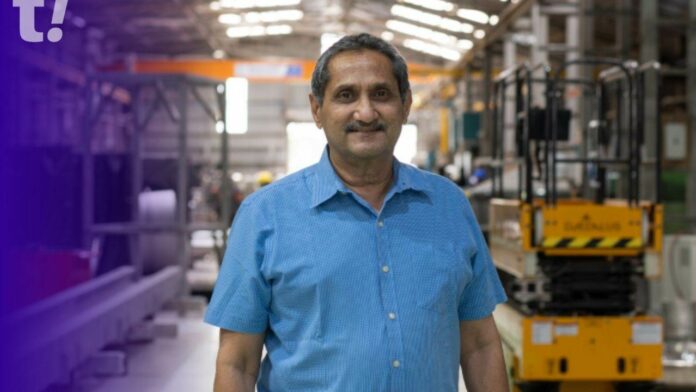During the interview with TechGraph, Mahesh Wagle, Co-Founder & CEO Of Cybernetik talked about, how the company keeps pace with ever-evolving automation and collaborative robots (cobots) technologies in manufacturing, and how they’re improving productivity, and creating opportunities for small manufacturers.
Read the complete interview:
TechGraph: Cybernetik is renowned for its expertise in Industrial Automation and robotics in the manufacturing sector. Could you provide an overview of the key technologies and solutions your company offers in this domain? How do these solutions enhance manufacturing productivity and efficiency?
Mahesh Wagle: At Cybernetik, we are committed to providing a single-source solution for all automation needs, driven by our mission to deliver excellence through technology, vision, and hands-on experience. Our focus has been on blending innovation and expertise to create comprehensive, turnkey automation systems that cater to industries such as Food, Chemical, Pharmaceutical, and more. Our solutions improve productivity and efficiency as they are customized to the client’s specific requirements.
Virtual Commissioning, Digital Twins, Vision Systems, Track and trace, Poka Yoke, 3D Modelling, Computational Fluid Dynamics (CFD) Analysis, Finite Element Analysis (FEA), Kinematic Simulation, and Offline Robot Programming are some of the tools we use towards this end. More importantly, we integrate these technologies into the equipment and the solution for seamless and precise operation.
In a recent EV Battery Assembly Line project, we were involved in concurrent engineering to cut turnaround time (TAT) by 6-9 months and achieve 100,000 units/year productivity. Here, we tweaked the working of the resistance welding unit as well as the robotic dispensers of sealant, thermal paste, and insulation foam for uninterrupted operations and minimal wastage.
Our Robotic Machining System for Wind Turbine Blades, which replaced special purpose machinery (SPM), doubled productivity while improving accuracy and cutting down rework. The last two deliverables undoubtedly improved efficiency by minimizing waste.
Cybernetik developed an industrial cooking system that automates the cooking, loading, and holding processes. The system delivers a high throughput of 900 kg/hr (customizable). It retains nutrients and flavor, has tools for real-time checks of cooking completion, and ensures minimal product loss during technical issues.
Another unique project we handled was the Carbon dioxide in Capsule Filling. The automation loaded the exact amount of CO2 at the prescribed temperature and pressure in sanitized and dimension-checked tiny capsules with pre- and post-weighing. Here again, the synchronized integration of elements delivered a high-productivity solution with top-class efficiency.
TechGraph: Industrial automation and robotics are rapidly evolving fields. How does Cybernetik stay ahead of the curve in terms of technological advancements? What steps does the company take to ensure that its offerings align with the changing needs and demands of the manufacturing industry?”
Mahesh Wagle: Necessity, we all know, is the mother of invention. You can add innovation and tweaks to that list. The quest, then, is to understand the necessity and fulfill it.
Trade shows and industry events are a great way to access what the market needs. Cybernetik’s teams actively attend and participate in such events at Indian and foreign locations. Apart from attaining the stated core objective, such participation helps us network with a cross-section of companies and individuals in automation.
Speaking with clients and prospects is another way to keep abreast of market developments and forecast future trends with reasonable accuracy. Our teams do this regularly when discussing projects.
What helps us stay ahead of the curve is the practical experience of our multifaceted teams that convert such captured requirements and estimates into vibrant solutions.
TechGraph: The implementation of robotics and automation in manufacturing processes often raises concerns about job displacement. How does Cybernetik address these concerns, and what strategies does the company employ to strike a balance between automation and preserving employment opportunities?
Mahesh Wagle: Instead of being a cause of unemployment as commonly believed, we hold the view that automation has the potential to create a shift in job roles and skill sets. Our belief is centered on the idea that automation can foster the development of new opportunities and bring about the evolution of existing roles within the workforce.
Instead of displacing workers, we envision automation as a catalyst for growth, enabling individuals to adapt and thrive in the changing landscape of employment.
Overall, automation is not a problem but a solution that creates new job opportunities that require upgraded skills. As long as upskilling remains feasible, automation can drive productivity and innovation while allowing human workers to focus on higher-value tasks such as R&D and process control.
TechGraph: In the context of industrial automation, cybersecurity is a critical aspect to consider. How does Cybernetik prioritize and address cybersecurity challenges to ensure automation systems’ integrity and safety? Are there any specific measures the company takes to protect against cyber threats?
Mahesh Wagle: Data is the very foundation of Industry 4.0. This is because smart factories put to use the actionable intelligence obtained from the evaluation of gigabytes and gigabytes of information for integrated improvement. The other side of the data coin is the cybersecurity challenges it creates in its wake.
Specifically, it is the combination of intellectual property (IP) with information technology (IT) and operational technology (OT) that generates these negative possibilities.
Cybernetik practices stringent Identity and Access Management for cybersecurity. This includes restricting the number of persons who have access to the network as well as implementing strict password controls. We also train our relevant clients in this regard.
TechGraph: Collaborative robots, also known as cobots, have gained popularity for their ability to work alongside human workers. Does Cybernetik offer collaborative robotics solutions? Could you provide examples of how these cobots have been successfully integrated into manufacturing environments to improve productivity and collaboration?
Mahesh Wagle: Cybernetik deploys cobot solutions in the box/carton palletizing space. Productivity improvement comes from its rapid, simple, and intuitive programming that allows deployment within minutes. Users can rapidly automate its complete workflow using the click and drag option, set locations, and assign operations. Besides, simple forklifts are enough to move the cobot between stations, and the in-built Vision System eliminates the need for jigs.
By providing cost-effective and practical cobot options, Cybernetik enables smaller B2B companies to improve their manufacturing processes without the need for full-fledged robotic automation. The rising demand for collaborative robots, especially among SMEs, makes the Indian market a significant opportunity for cobots.
TechGraph: Sustainability is a growing concern for many industries. How does Cybernetik contribute to sustainable manufacturing through its automation and robotics solutions? Are there any specific features or functionalities in your offerings that promote energy efficiency or reduce waste in manufacturing processes?
Mahesh Wagle: Cybernetik adopts a holistic view of sustainability, one that confirms optimal resource utilization. We build systems that use the least resources in terms of electricity, water, fuel, and material when in operation. And we build them using the minimum possible resources.
The role of Electric Vehicles (EVs) in ensuring sustainability doesn’t need any explanation Cybernetik is actively involved in the development, design, and building of tailored solutions for EV battery assembly. We have already mentioned the minimization of wastage we achieved. The End-of-Line Testing Unit of the same project has a Regenerative Discharging feature that returns electricity to the utility supplier.
Wind energy is another tool for sustainable development. Speaking of features or functionalities in our offerings, the aforementioned Robotic Machining System for Wind Turbine Blades virtually eliminated rework via superior accuracy. This saves the resources needed for rework. At present, we are working on a Robotic Multipurpose Vehicle (RMV) for Spray Painting Wind Turbine Blades. Among other deliverables, the RMV will virtually eliminate rework.
Next is our Substrate Coating Automation to coat Catalytic Converters used to reduce carbon monoxide emissions from two-wheelers, passenger cars, and heavy-duty vehicles. As always, the process flow is geared towards optimal resource use.
For many food and pharmaceutical solutions, we provide a Clean Place (CIP) System. For a typical industrial cooking system of 900 kg/hr, the CIP System saves around 1000 liters of water in a typical cleaning cycle.
TechGraph: Looking ahead, what emerging trends and challenges does Cybernetik anticipate in the automation and robotics industry? How is the company preparing to stay ahead in this rapidly evolving landscape?
Mahesh Wagle: In the rapidly evolving landscape of the automation and robotics industry, Cybernetik anticipates several emerging trends and challenges. Industry 4.0 technologies, including Artificial Intelligence (AI), Machine Learning (ML), Virtual Reality (VR), Industrial Internet of Things (IIoT), predictive data analytics, and Augmented Reality (AR), will continue to advance and drive manufacturing towards more data-driven operations. This shift will lead to a transition from automation to autonomous operations, as technology enables greater capabilities.
While integrating automation and robotics into manufacturing processes can pose challenges such as initial costs, system integration, workforce training, maintenance and repair, and safety, Cybernetik prepares to overcome these obstacles through meticulous planning.
This includes conducting comprehensive cost-benefit analyses, providing extensive employee training, implementing robust safety measures, and establishing proactive maintenance and repair plans. By taking these measures, manufacturers can achieve seamless integration, mitigate challenges, and maximize the long-term benefits of automation and robotics.
By leveraging Industry 4.0 technologies, carefully balancing customer demands, and implementing comprehensive planning strategies, the company is committed to staying ahead and providing cutting-edge solutions to its clients.



